For most first-time visitors who stop and linger in West Texas, and for those hurtling past at or above the 85-mph speed limit, the land’s expansiveness startles with a stark, almost otherworldly beauty. On a clear day, dust storms willing, one can see across the flatness to the limit of human vision, the horizon alternating between beckoning and foreboding. The sheer scale of the sky that persuaded Donald Judd to trade Soho for Marfa self-dilutes its blue to a shade paler than versions further east. The scene has long attracted painters working in oil, acrylic, and watercolor, and photographers analog and digital, color and black-and-white. The most familiar images of West Texas that don’t silhouette pumpjacks and windmills against the dazzling red, orange, and purple sunsets often feature the unforgiving texture of caliche, the prickly pear cactus and the creosote bush, the bleached firmament, the ubiquitous barbed-wire fences, and the occasional distant jut of the Chinati Mountain range.
For those of us who grew up in West Texas, including Midland artist Catherine Allen, whose stunning solo show En Route currently appears in Texas A&M University’s Wright Gallery, the sparsely settled Chihuahua Desert conjures all kinds of dissonances: liberation and constraint, scarcity and abundance, infinitude and containment. Organized by Texas A&M Professor Emerita Karen Hillier and expertly curated by artist, lecturer, and curator Rebecca Pugh (both of whom are, full disclosure, my colleagues), En Route refracts those dissonances in brilliantly colored digital sketches and vibrantly textured oil on canvas. The exhibit’s title refers to Catherine Allen’s artistic process: capturing images on her smartphone, often from her car, as she passes along streets and highways in Midland, Marfa, and the surrounding areas. The resulting photos serve as the raw materials for her seamlessly collaged digital sketches and geometrically sectioned and rendered representational oil paintings.
En Route resonates well beyond the artist’s daily commutes. West Texas lies in the Mid-continent oil field province, one of the nation’s most plentiful sources of fossil fuels. And Midland, perhaps more than any other city in the Permian Basin, is a city always en route — from boom to bust, from broke to flush, from conventional drilling methods to fracking, from reckless philanthropic largesse to bankruptcy and back again. In Midland, no one counts on anything lasting for too long, and very few of the city’s long-term residents complain about the cycles of change. Catherine Allen’s paintings tap into that melancholic optimism (optimistic melancholy?) that defines West Texans’ collective consciousness.
A digital sketch titled Burning Bush greets the viewer and sets the tone: plastic bags, whipped and shredded by the relentless West Texas winds, snag on the thorns of a leafless roadside bush. Large tire tracks in red soil fill the foreground. Fragmenting passages of dry grass lead the eye across a barbed wire fence to mountains in the distance. Electric wires converge to a vanishing point atop an impossibly tall telephone pole, interrupting the horizontal rhythms of tire tracks, grassland, fence, and flattened mountains. The patchwork effect conveys temporality through the accumulation of plastic bags. The resulting portrait of the bush reads as having resulted from multiple “sittings.”
In a particularly appealing maneuver, the uppermost bags and branches cast shadows on the surface of the digital sketch and, in turn, read as shadows on the sky. Both prophecy and lament, the sketch invokes the biblical story of the bush that burned without being consumed by the flames. Allen leaves sufficient interpretive space for deep reflection on combustion, revelation, and, ultimately, liberation.
Other digital sketches scattered throughout the show engage themes of commerce, consumption, development, leisure, luxury, demolition, and the visual, spatial, and material consequences of humans’ impact on the desert wilderness. Man Camp depicts a construction site with a dozen or so single-wide mobile homes, a single-story office building in the distance, and objects that recur throughout the show: a pickup truck, tire tracks, excavated soil, telephone poles, and power lines. Yard Sale, staged in the driveway of a small, brick front house flanked by two enormous palm trees, offers furniture, clothing, and decorative objects. A gas guzzling SUV crowds the goods on sale, and a boat sits atop a trailer adjacent to one of the palm trees, with a disproportionately large water tower looming in the background. The trees cast shadows on the picture plane, creating the effect and affect of a stage set. New Construction comprises three tract houses, photographed at different times of day and collaged to appear as if they are part of the same neighborhood development. In all three sketches, as in many of the oil paintings, a sun and/or moon surveils the scenes below.
Allen transliterates the digital sketch collaging technique to the surfaces of her precisely and vividly representational oil paintings, and in so doing evokes various precedents. Blocks of color and changing light effects pay homage to Cezanne’s Mont Sainte-Victoire series and Monet’s Rouen Cathedral paintings. The aggressive brushwork of lawns, trees, and plant life, and the tribute flowers laid along a deadly border crossing, all conveyed through an intense sense of ambiguity without ambivalence, bring to mind Mary Cassatt and Berthe Morisot. A leaping dog appears as if captured by Edweard Muybridge’s chronophotography. Undercurrents of detachment and isolation stir thoughts of Edward Hopper. A leafless tree juxtaposed with a 75-mph speed limit sign resembles early Piet Mondrian. Two delightful surrealist studies of levitating architectural features, one of a window with aluminum foil protecting privacy and reflecting hot sunlight, and another of a commercial sign with its interior fluorescent ballasts and bulbs exposed, summon Dorothea Tanning and Dan Flavin. And in the rising thunderheads, retreating storms, and smoke plumes from a house fire, one may reasonably apply John Constable’s dictum: “the sky is the organ of sentiment.” These associations are, of course, those of an art historian. Catherine Allen’s paintings stand on their own without any such references to validate their artistic merit or their aesthetic potency.
The portraits of houses and mid-rise office buildings that dominate the exhibit both intrigue and perplex. Standing alone as sculptural objects set against eroded soil, dry grass, a tilled field, or a dirt road, these buildings read as if in a state of exhaustion, respiration, or expansion and contraction. By emphasizing the parallax effect of seeing the same object from different angles and through the mediating surfaces of a car window or windshield, Allen plays with space, time, and perception.
This play extends to Allen’s oil portraits of houses. Are they under construction? Are they awaiting demolition? Should they be condemned? Are they occupied? Are they abandoned? Are they awaiting future occupants? Whatever the answers, these houses, like Allen’s buildings, function as characters in the rural and urban fabrics of West Texas and the collective consciousness of West Texans.
Catherine Allen’s paintings testify to the cycles of boom and bust, construction and demolition, and ambition and collapse inherent to the state’s oil and gas economies. West Texans are a resilient lot, and En Route invites the viewer to consider what is next for an environment ravaged by our dependence on fossil fuels and for a people whose identities are permanently linked to that dependence.
Catherine Allen: En Route is on view at Wright Gallery at Texas A&M University through March 3, 2022.


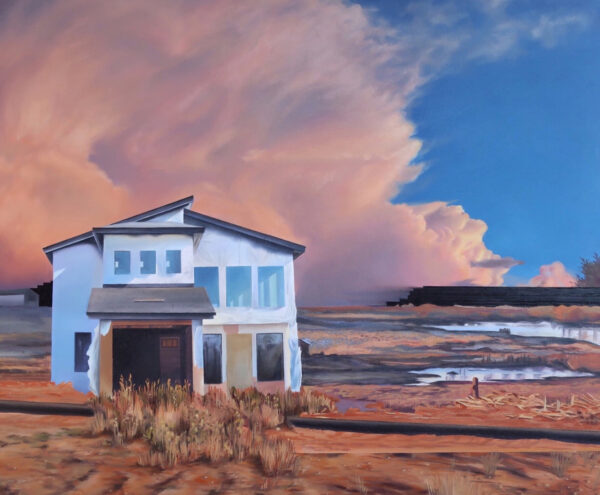
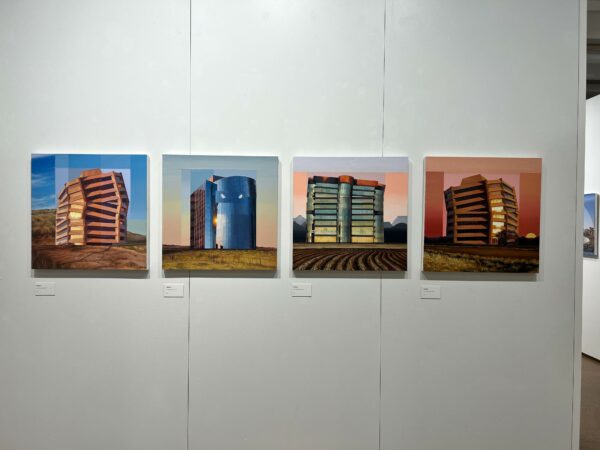
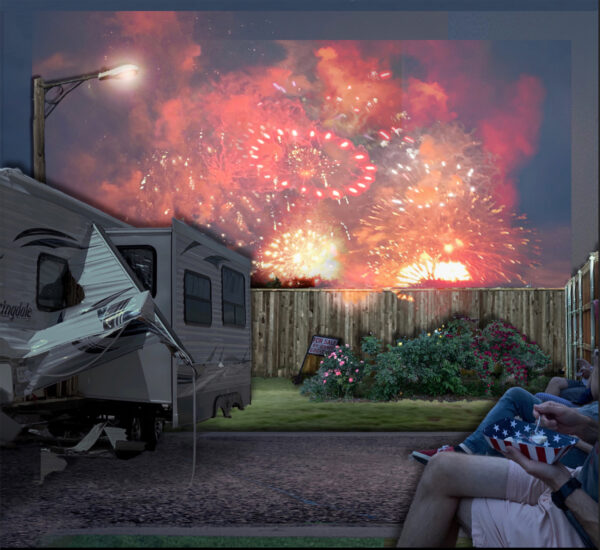
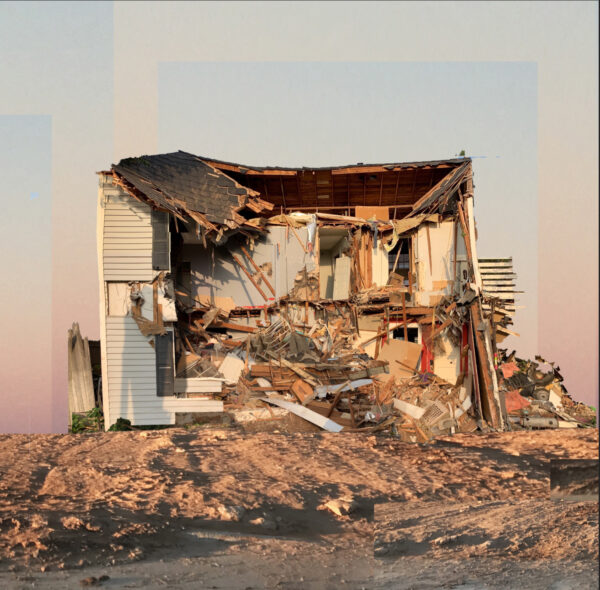
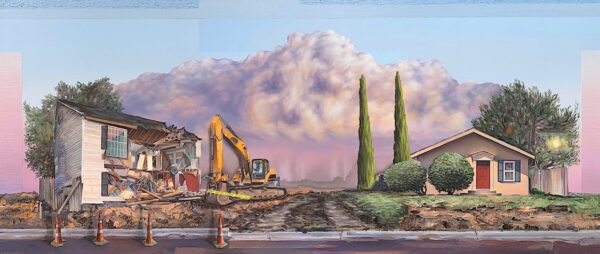

2 comments
Boom and bust? Ambition and collapse? Melancholic optimism? These words, and these works, beautifully capture the utter dissonance of the West Texas vibe. Bravo!
I caught the show on the last day, and discovered a new favorite artist.
This is the internal video of someone who has lived in a place for a long time, and who wants to show us the pathos of loss. Allen balances a mastery of subtle traditional landscape painting with hyper-detailed renderings of falling, failing manmade elements: even as they still stand they succumb to uncreative destruction. The artist collages and paints every detail, every crack and bit of debris, with a specificity that honors this place at this time, even as she sees into the past and future with a transcending vision.
Allen’s painting techniques match her intent. She gifts us with Easter eggs of signs, almost-animations, and cast shadows that question the honesty of the images. She delights us with a rich slightly-off palette, blocks of gradations, and horizontal striations in the sky as if a comb was pulled across the paint. Her buildings often stand alone, portraits of a place and people under duress.
Thanks go to the eloquent Stephen Caffee for his review of this recent show of Catherine Allen’s work at the Wright Gallery at Texas A&M University.